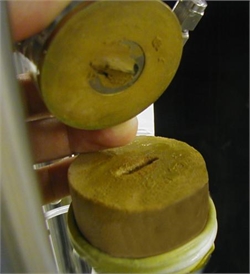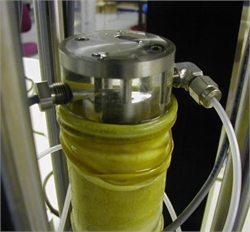THE PROBLEM
When performing bender element tests, good contact or ‘coupling’ with the soil is critical to obtaining clear results. On a soil sample, the element can either be pushed in, as in the case for soft clay, or created around the element itself for samples such as sand.
Performing bender element tests on rocks however can create a problem, because it is not obvious how to insert the element. At GDS we decided to investigate this problem.
THE SOLUTION
Using a sample of sandstone as our test piece, we decided to carefully carve a slot in each end suitable for the bender element to be inserted. This was performed with a craft knife. The slots were deep enough such that the elements could be cleanly inserted into the ends of the sandstone unobstructed (great care was taken to ensure the slots were not too big, in fact they were ‘just’ large enough to house the bender element), see Fig 1.
The slots were then filled with soft clay to provide the coupling between the bender element and the sandstone.
Once we were happy that there was a good fit between the element and the sample we rolled up the membrane, inserted the sample in to a triaxial cell and ran a series of tests, to determine the accuracy of this sample preparation method. | 
Fig 1. Shows the sandstone sample with the slot cut out for the bender element.

Fig. 2 Shows the bender element sample within the triaxial cell. |